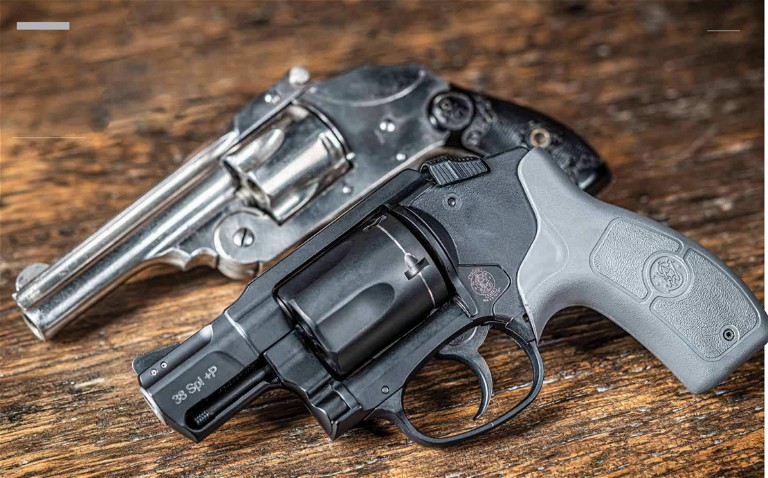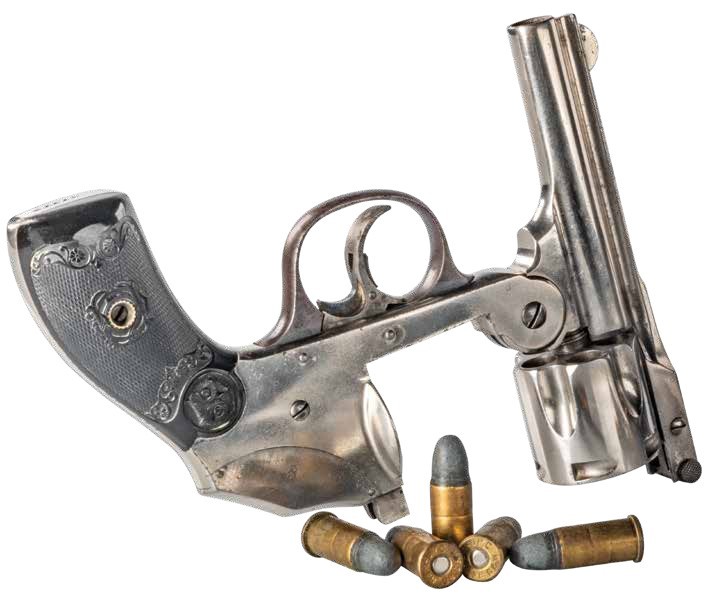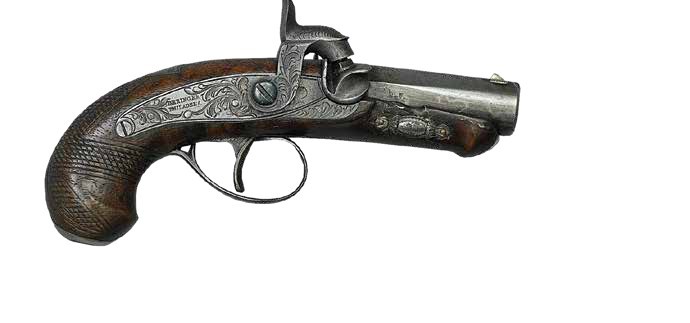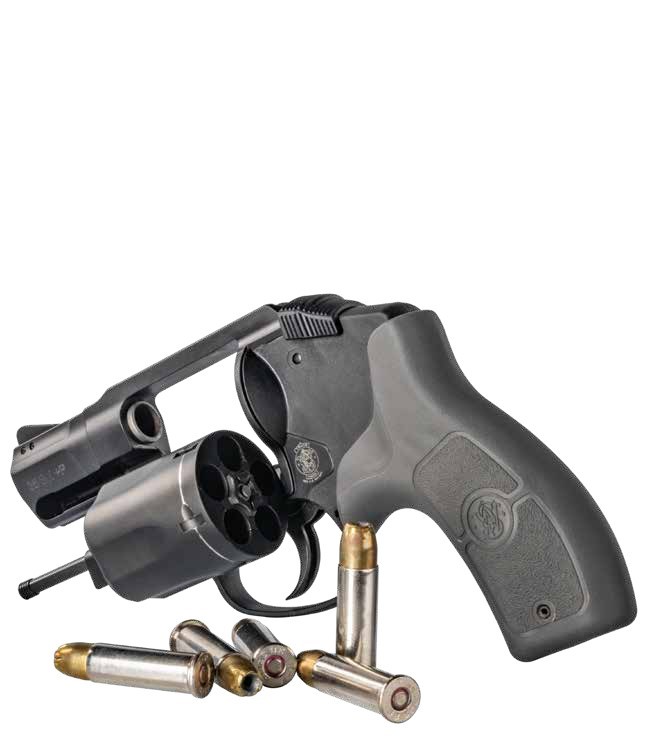SCOTT W. WAGNER
POCKET PISTOLS
THEN AND NOW

A LONG ROAD
American pocket guns followed a different path than their European cousins. While the Euros adopted the semi-automatic almost as soon as it was available, revolvers maintained their dominance stateside until almost the end of the 20th century.
Throughout history, pocket pistols have occupied the largest share of the defensive handgun market. But what is a “pocket pistol,” anyway? Well, it’s a defensive handgun that is small enough to be concealed long-term in a pocket or similar-sized area for use in unexpected emergencies.
The pocket pistol dates back to the 17th century, when the flintlock firing mechanism made it safer to carry a loaded gun in a coat or belt. Such a handgun could be carried in a pocket, even though it probably ranged from 7 to 9 inches long and was not what we would consider “pocket-sized” today. Men who could afford firearms back then normally wore coats with very large external and internal pockets, so storage was only so much of an issue.
Over time, carrying a weapon for protection fell out of fashion in many parts of the world. In fact, an open display of weaponry other than by the military could be seen as gauche among the elite. For those who felt the need to be discreetly armed, smaller flintlock and, later, percussion-cap designs were developed. Many arms of various designs came and went with varying degrees of success, but Samuel Colt’s revolvers had the most profound and lasting impact.
MID-19TH CENTURY AMERICA
Samuel Colt patented the first truly successful revolving-cylinder handgun, the Colt Paterson revolver, in 1836. In 1847, Colt introduced the mammoth .44 Walker percussion revolver as well as diminutive pocket percussion revolvers in both .28 and .31 caliber. Although not what we would consider a man-stopper by today’s standards, the .31-caliber version in particular found favor on the frontier, especially during the California Gold Rush. Out in the gold fields of California, where claim jumpers and other rough sorts abounded, the .31-cal Colt Pocket revolver was an important and convenient insurance policy.
The film Unforgiven (1992) notably features a Colt Pocket Model when Sheriff “Little Bill” Daggett (Gene Hackman) confronts English Bob (Richard Harris). After reluctantly surrendering his primary Colt to one of Daggett’s deputies, Daggett stops the Englishman and demands he turn over his pocket pistol. English Bob declares, as he pulls it from his vest, “Now Little Bill, you will leave me at the mercy of my enemies?” Even if it’s a fictional portrayal of life in 1880, the scene accurately recognizes the role of the pocket gun as a backup arm during this period in history.

GENERATION AFTER GENERATION
Pocket pistols have been clutch players on the defensive handgunning roster for centuries.
Other types of pocket pistols besides Colt’s revolutionary design did exist. One of the most famous was the derringer. John Wilkes Booth notoriously used a .44-caliber derringer to assassinate President Abraham Lincoln in 1865. Other unique mid-19th century pocket-pistol designs included the turnover, pepperbox and bar-hammer pistols.
Introduced in 1857, the Smith & Wesson Model 1 was the first truly practical pocket pistol. The company also presented the .22 Short cartridge to the world. The seven-shot Model 1 was a favorite among officers and soldiers during the American Civil War because of its easy concealability and operation.
It was extremely quick to reload in comparison to the percussion handguns of the period, even though its black powder .22 Short cartridge had less power than the .31-caliber Colt. The Model 1 was followed by the Model 2 Army, which was chambered in the .32 Rimfire Long cartridge. A host of additional rimfire cartridges appeared from various makers, including the .41 Rimfire used in the two-shot Remington Model 95 (or “Double Derringer”), which remained in production for 69 years. Rimfire cartridges paved the way for the more powerful and reliable centerfire cartridges.
“ THE EARLY 1900S MARKED THE METEORIC RISE OF SEMI-AUTOMATIC POCKET PISTOLS IN AMERICA. BECAUSE SUITS AND OVERCOATS WERE COMMONLY WORN BY MEN OF THE 20TH CENTURY, RELATIVELY LARGE POCKETS WERE STILL COMMON. ”
THE GOLDEN AGE
Centerfire rounds such as .32 Short and Long Colt, .38 Short and Long Colt, and .41 Short and Long Colt — and their counterparts, such as the .32 Smith & Wesson and .32 Smith & Wesson Long — popularized small five- and six-shot double-action revolvers manufactured by other companies during the latter part of the 19th century. Guns produced by Iver Johnson, Harrington & Richardson and others became popular among individuals seeking reliable, concealable and affordable self-defense handguns.
The early 1900s marked the meteoric rise of semi-automatic pocket pistols in America. Because suits and overcoats were commonly worn by men of the 20th century, relatively large pockets were still common. The M1903 and the M1908 Colt Pocket Hammerless introduced the .32 ACP (Automatic Colt Pistol) and the .380 ACP to the self-defense world. Elegant, large and heavy by today’s standards, the Colt autos chambered cartridges of marginal effectiveness, but nonetheless fit in coat pockets of the day. Their hammerless configurations made for smooth draws — much like with the Smith & Wesson Safety Hammerless Revolver. These were among the first handguns with factory modifications to enhance carry and combat effectiveness. Hammerless revolvers are the only handguns that can fire repeated shots directly through a coat pocket without being withdrawn from it, as there are no exposed hammers or slides to snag or jam. They retain that distinction today.
In 1908, Colt introduced another variant on the pocket pistol: the Model 1908 Vest Pocket. Designed by John Moses Browning, the tiny Model 1908 was an extremely popular design. Its extremely compact size and sights made the M1908 an arm’s-length weapon. It fired a .25 ACP cartridge, which was a smokeless-powder-charged centerfire cartridge loaded with an FMJ bullet. It was highly reliable and more practical than the black powder .22 LR ammunition of the day. The M1908 remained in production for four decades.
ROARING 20S INTO WWII
Not until the 1920s did the classic pocket semi-auto reached its zenith. Carl Walther GmbH Sportwaffen introduced the marvelous .32 ACP and later .380 ACP PP and PPK series of “Polizeipistole” in Germany. Originally developed for European police belt carry, they quickly became favored for pocket carry by detectives. The Walthers revolutionized pocket pistols with their double-action/single-action operating systems. This allowed them to be safely carried with a round in their chambers, instantly ready to fire with their manual safeties off — much like revolvers but with a higher cartridge capacity. Their trim dimensions, steel construction and fixed barrels made them very accurate and easy to shoot. I carried one off-duty and as a primary gun on the narcotics unit and never experienced a malfunction with it.
The financial crisis of the Great Depression, the outbreak of World War II and the limitations imposed by the advent of gun-control measures in the 1920s and 1930s all worked to hamper the development of new pocket pistols during this period. People and companies had little money, and World War II limited the production of civilian arms due to war demand. Also, gun control clamped down on concealed firearms — especially in the major cities, where there were waves of gangster crime during Prohibition. Note that up until 1934, American citizens could walk into a hardware store and buy a Thompson submachine gun without any paperwork. The introduction of the National Firearms Act by Congress during President Franklin Roosevelt’s presidency changed that.
UP UNTIL NOW
The trend of “shall-issue” concealed carry permitting really began in Washington state in 1961. But Florida’s adoption of it in 1987 is generally regarded as a watershed moment. That’s because handgun and carry-method developments really took off once shall-issue permitting was adopted in the Sunshine State. Other states, such as Pennsylvania, Oregon, West Virginia, Idaho and more, used Florida’s model as a template for their own laws. Today, constitutional carry has been adopted by 23 states, doing away with the requirement to possess a permit to carry a firearm.
Prior to shall-issue permits, there wasn’t much in the way of pocket pistols from which to choose. There were the Walther PP pistols; .38 Special revolvers; and various .25 ACP, .32 ACP and .380 ACP pistols of varying — often imported — brands. There wasn’t a demand for new variations because only cops and the very few people who were politically connected enough to possess “may-issue” permits could legally carry concealed. And there simply weren’t enough cops to drive a manufacturing boom. Like many others during the 1980s, my municipal agency allowed only .38 Special revolvers for off-duty carry. This policy was so universal that a snub-nosed revolver was instantly known as a “cop gun” by the criminal element, which is why I didn’t carry one when I was working deep undercover for my first six months with the narcotics unit.

THE OLD ‘5 FOR SURE’
Affordable top-break revolvers like this Iver Johnson were some of the most popular options for the average American man or woman from the turn of the 20th century through the first few decades after World War II.

BOOTH’S DERRINGER: TO DISPLAY OR NOT TO DISPLAY?
■ On April 14, 1865, John Wilkes Booth snuck into the presidential box at Ford’s Theatre in Washington, D.C., and shot President Abraham Lincoln in the back of the head. The assassin dropped his weapon, a .44-caliber derringer, and fled the scene. A patron of the theatre, William T. Kent, discovered Booth’s derringer on the floor and delivered it to the Metropolitan Police Department, which then turned it over to the War Department. In 1931, Ulysses S. Grant III contacted Adjutant General of the U.S. Army Charles Higbee Bridges and requested to display the pistol at Ford’s Theatre. “The relics should not be displayed to the public under any circumstances, on the theory that they would create interest in the criminal aspects of the great tragedy rather than the historical features thereof,” wrote Bridges, “and would have more of an appeal for the morbid or weak-minded than for students of history.” Nine years later, the War Department yielded and transferred the pistol to the theatre’s museum. In 2018, members of the museum’s staff debated the ethics of displaying the pistol to the public. They settled on adding signage to the exhibit with Bridges’ quote and a QR code asking visitors to comment if they thought it was appropriate to display the weapon.
— Frank Jastrzembski, Contributing Editor
Today, technological advancements driven by private-citizen demand have allowed manufacturers to fit the .380 round into pistols the size of previous generations of .25s and .32s. Speaking of .25s, they have all but disappeared from the market, and ammo is very hard to find. This is because the .22 LR has taken its place. The .22 LR round, coupled with high-velocity loadings, has proven very reliable in guns that are the same size as many of the previous .25-caliber pistols, giving them a significant market share.
Of greater significance is the demand for a never-ending stream of 9mm pocket pistols — and the fact that the 9mm has virtually wiped out the .40 Smith & Wesson in new handgun models. It happened almost overnight after the FBI declared the .40 S&W and the 9mm to be equals in terms of stopping power. (I never bought into this.) Regardless, the 9mm has less recoil than the .40 and is a better fit in what are now called “micro-compact” pistols. A micro-compact will fit in a pocket, and the new breed of handgun packs far more punch than any previous generation of pocket pistols. (A pocket holster is essential for all pocket carry, but especially with modern striker-fired nines since many do not have manual external safeties.) Special 9mm loads with reduced recoil but still with more power than most .380 loads are also available.

NEW AND IMPROVED
Continuous snubnose development brought us to the Smith & Wesson Bodyguard, which is essentially everything you need in a pocket .38 Special and nothing you don’t .
“ TODAY’S DEFENSIVE AMMUNITION IS ALSO MUCH BETTER THAN IT WAS PRIOR TO THE CONCEALED CARRY BOOM. THERE ARE SO MANY DIFFERENT STYLES OF RELIABLY FEEDING AND EFFECTIVE HOLLOW-POINT AND OTHER DEFENSIVE-BULLET DESIGNS THAT IT BOGGLES THE MIND. ”
‘FIVE FOR SURE’ STILL APPLIES
The revolver has not stood still either. The snub-nosed revolver remains very popular — enough so that new models are regularly introduced in newer chamberings, such as the .327 Federal Magnum. Speaking of magnum rounds, the .357 Magnum cartridge has been chambered in revolvers by all of the major manufacturers, although most of them are probably carried with the lighter-recoiling .38 Special. Certainly more time is spent sending .38s downrange. But the .357 Magnum has been providing a decisive punch since 1935.
The sales preference for any of the pocket revolvers is the hammerless style. My most frequently carried pocket revolver is a Smith & Wesson fiveshot M&P Bodyguard with a concealed hammer and built-in Crimson Trace laser sight. It is lightweight, the trigger is great, and the pistol is accurate. I generally carry it in my left-front pocket. This is the same location I carried it for backup when I worked the streets, and I carry my .380 M&P in the same location when I want to maximize concealment.
Today’s defensive ammunition is also much better than it was prior to the concealed carry boom. There are so many different styles of reliably feeding and effective hollow-point and other defensive-bullet designs that it boggles the mind. In fact, I was surprised just the other day to see the introduction of the new .30 Super Carry cartridge and two Smith & Wesson pistols chambered for it. It gives power levels at or above the 9mm — with lower recoil — while its narrower diameter allows two additional rounds in the magazine. It shows a great deal of promise and may even be adopted by law enforcement agencies.
CONCEALABLE AND AFFORDABLE
As long as we maintain our constitutional rights, the pocket pistol will continue to be an important part in maintaining those rights and our safety. It is relatively powerful and easy to pack and is typically chambered in a cartridge that is easy to control. Most are also affordable, keeping lawful self-defense within reach for all. In fact, when all of its characteristics are weighed, it is difficult to name a style of firearm that better epitomizes the ethos of the responsibly armed American than the pocket pistol.